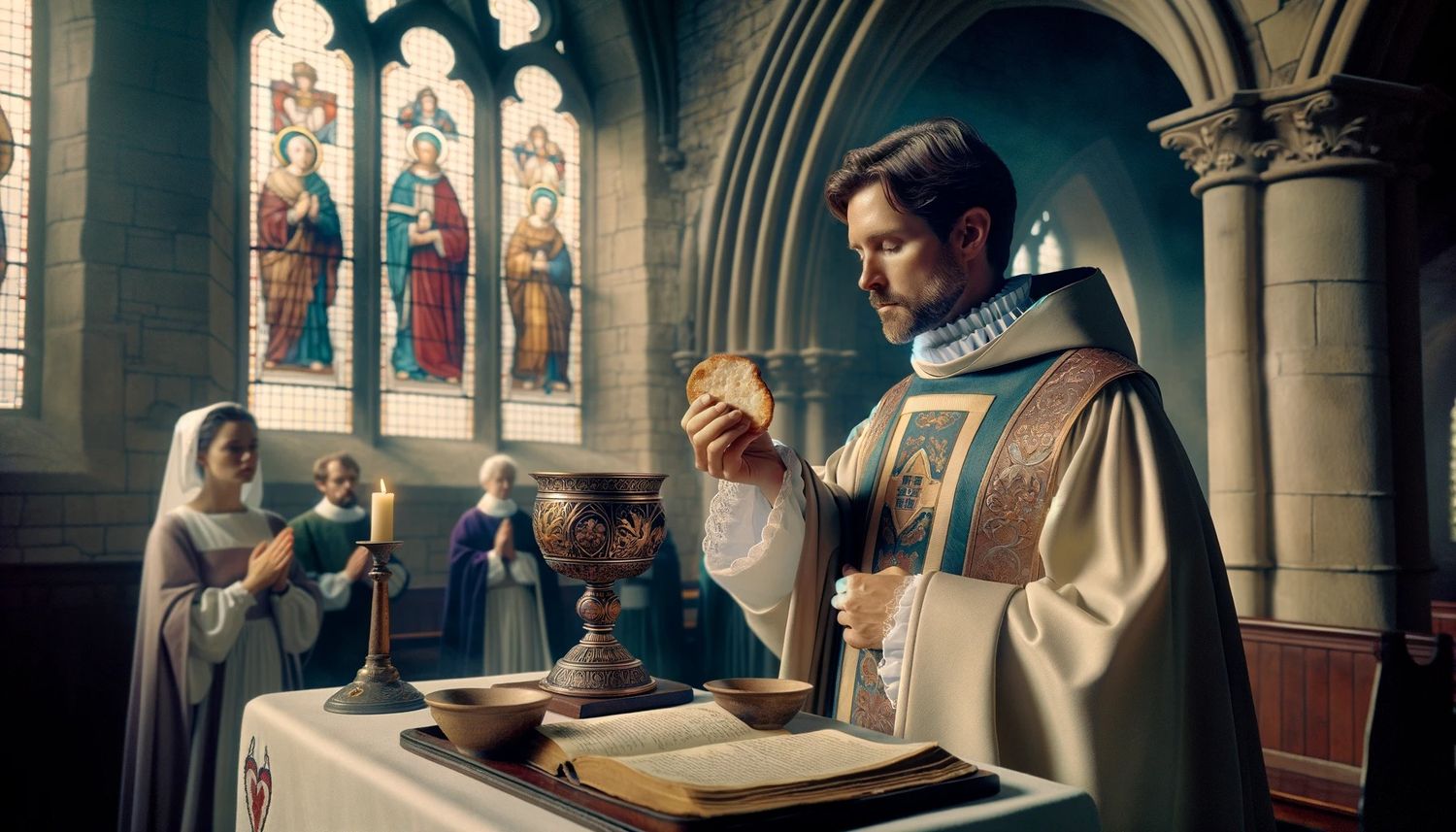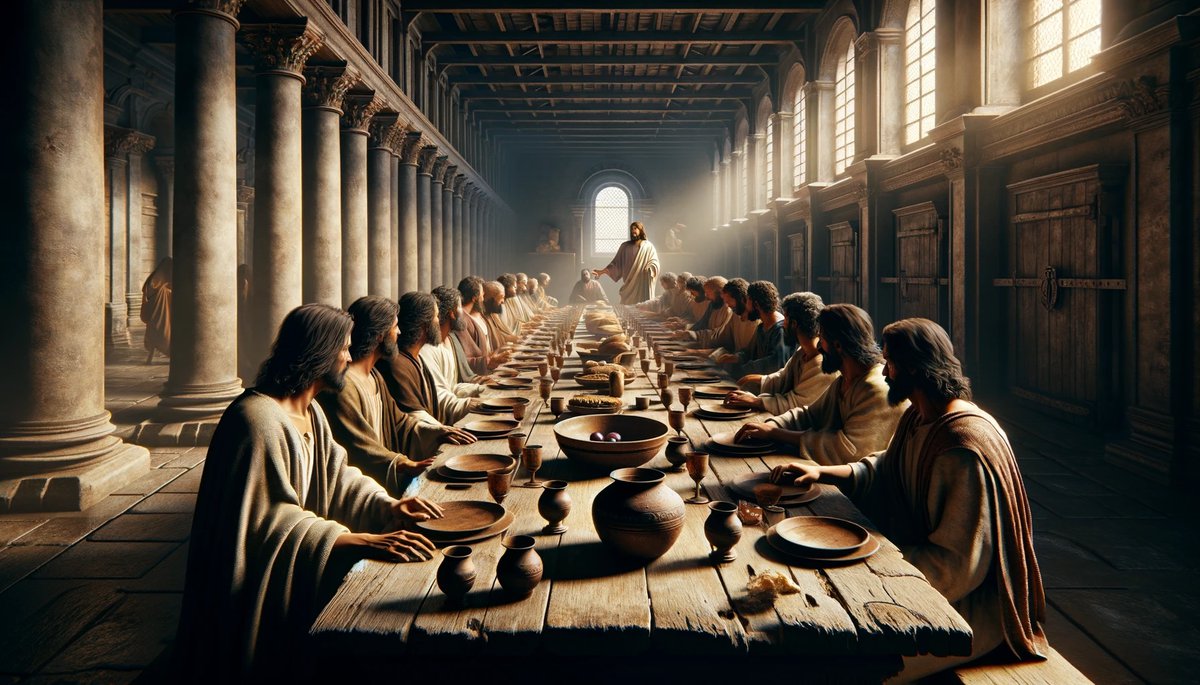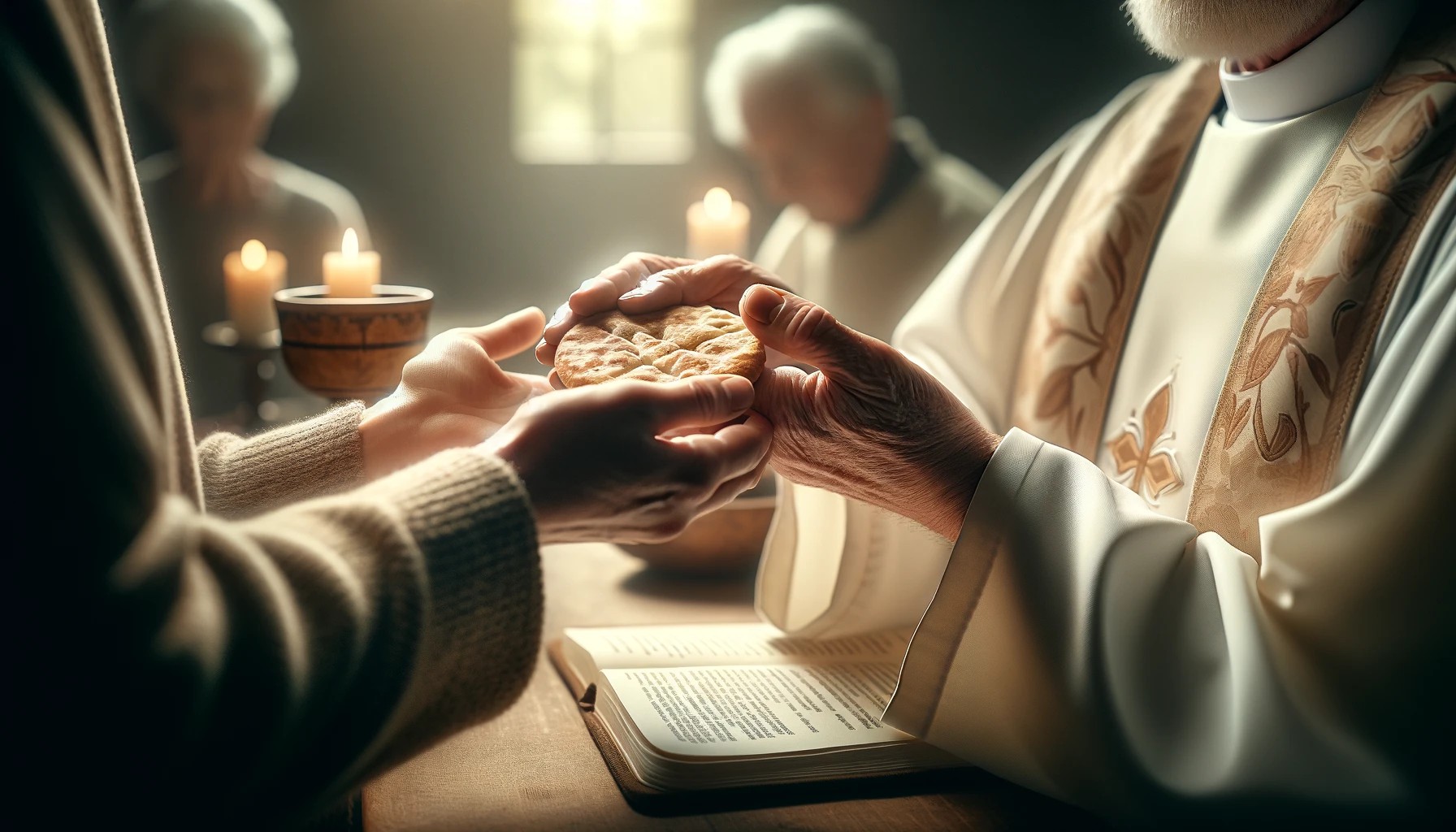Home>Theology and Spirituality>Why Use Unleavened Bread For Communion


Theology and Spirituality
Why Use Unleavened Bread For Communion
Published: February 25, 2024
Peter Smith, Editorial Director at Christian.net, combines deep insights into faith, politics, and culture to lead content creation that resonates widely. Awarded for his contributions to religious discourse, he previously headed a major organization for religious communicators, enhancing dialogue on faith's societal impacts.
Discover the significance of using unleavened bread for communion and its theological and spiritual implications. Explore the reasons behind this practice and its importance in religious traditions.
(Many of the links in this article redirect to a specific reviewed product. Your purchase of these products through affiliate links helps to generate commission for Christian.net, at no extra cost. Learn more)
Table of Contents
Introduction
The practice of using unleavened bread for communion has been a longstanding tradition in many Christian denominations. This seemingly simple element holds deep significance and symbolism within the context of the communion service. Understanding the reasons behind the use of unleavened bread can provide profound insights into the spiritual and historical foundations of this sacred ritual.
Unleavened bread, also known as "matzo" in Hebrew, is a type of bread made without yeast or any leavening agents. Its flat and simple form carries a rich history that dates back to ancient times. The use of unleavened bread in communion is not merely a matter of tradition; it is rooted in the very fabric of religious and spiritual symbolism.
In this article, we will delve into the multifaceted significance of unleavened bread in the Bible, explore its historical use in communion, and uncover the practical and symbolic reasons for its continued use in this sacred sacrament. By shedding light on these aspects, we aim to deepen our understanding of the profound spiritual and theological implications associated with the use of unleavened bread in communion.
Read more: What Bread Is Used For Communion
The significance of unleavened bread in the Bible
Unleavened bread holds significant importance in the Bible, with its symbolism deeply rooted in both the Old and New Testaments. The concept of unleavened bread is first introduced in the book of Exodus, during the Israelites' exodus from Egypt. As they prepared to leave, there was no time for their bread to rise, leading to the consumption of unleavened bread. This event marked the beginning of the Feast of Unleavened Bread, a commemoration of their hasty departure and subsequent liberation from slavery.
The absence of leaven in the bread carries profound symbolism. In biblical contexts, leaven often represents impurity, sin, and corruption. The removal of leaven during the Feast of Unleavened Bread symbolizes the purification and consecration of the people of Israel as they embarked on a new chapter in their journey. This act of consuming unleavened bread served as a tangible reminder of their dependence on God and their commitment to living in accordance with His will.
In the New Testament, the significance of unleavened bread is further emphasized in the context of the Last Supper, where Jesus shared a meal with his disciples. During this pivotal event, Jesus took unleavened bread, blessed it, and broke it, instructing his disciples to partake of it as a representation of his body. This act established the foundation of the sacrament of communion, where the consumption of unleavened bread became a central ritual in remembrance of Jesus' sacrificial offering.
The symbolism of unleavened bread in the Bible extends beyond its historical and cultural significance. It serves as a powerful metaphor for purity, sincerity, and the absence of spiritual corruption. The unleavened bread used in communion embodies the unadulterated nature of Christ's sacrifice and the call for believers to partake in a manner that reflects spiritual purity and devotion.
In essence, the significance of unleavened bread in the Bible transcends mere dietary restrictions or cultural practices. It embodies profound spiritual truths and serves as a tangible representation of God's redemptive work and the call for believers to lead lives marked by sincerity and spiritual purity. This rich symbolism underscores the enduring relevance of unleavened bread in the sacred observance of communion, connecting believers to the foundational narratives of faith and redemption found in the Scriptures.
Historical use of unleavened bread in communion
The historical use of unleavened bread in communion traces its origins to the early Christian church and the practices established during the time of Jesus and his disciples. The tradition of using unleavened bread during the Last Supper, as recorded in the New Testament, laid the groundwork for its continued significance in the communion service.
In the early Christian communities, the practice of using unleavened bread for communion was closely linked to the Jewish roots of the faith. The influence of Jewish customs and rituals, including the observance of Passover, shaped the early Christian understanding of the Eucharist. As a result, the use of unleavened bread, reminiscent of the bread consumed during the Passover meal, became intertwined with the commemoration of Jesus' sacrificial offering.
The writings of early church fathers, such as Ignatius of Antioch and Justin Martyr, provide insights into the early Christian practices surrounding the Eucharist. These historical accounts reveal the prevalence of unleavened bread as a central element in the celebration of communion. The emphasis on using unleavened bread reflected a deliberate connection to the scriptural narratives of the Last Supper, reinforcing the continuity between the Old Testament symbolism of unleavened bread and its fulfillment in the person of Jesus Christ.
As the Christian church evolved and expanded, the use of unleavened bread in communion became standardized within various Christian traditions. The theological significance attributed to the unleavened bread, particularly in representing the body of Christ, solidified its enduring presence in the communion ritual. The preservation of this historical practice served to maintain a tangible link to the foundational events of Jesus' ministry and the establishment of the Eucharistic tradition.
Furthermore, the historical use of unleavened bread in communion underscores the continuity of the sacramental tradition across different epochs of Christian history. The preservation of this practice reflects a commitment to honoring the scriptural and historical roots of the communion service, ensuring that the profound symbolism and spiritual significance associated with unleavened bread remain integral to the worship and spiritual life of believers.
In summary, the historical use of unleavened bread in communion is deeply intertwined with the early Christian practices and the scriptural accounts of the Last Supper. This historical continuity underscores the enduring significance of unleavened bread as a central element in the sacred observance of communion, serving as a tangible link to the foundational events of Jesus' ministry and the establishment of the Eucharistic tradition.
The practical reasons for using unleavened bread in communion
The use of unleavened bread in communion is not only steeped in spiritual and symbolic significance but also encompasses practical considerations that contribute to its continued relevance in this sacred ritual. From its composition to its suitability for the act of breaking and sharing, several practical reasons underpin the choice of unleavened bread for communion.
First and foremost, the composition of unleavened bread aligns with the scriptural and historical accounts of the Last Supper. The absence of leaven, which symbolizes impurity and corruption in biblical contexts, underscores the purity and sincerity of the bread used to represent the body of Christ. This adherence to biblical precedent ensures that the elements utilized in communion faithfully reflect the scriptural narratives and theological symbolism associated with the Eucharistic tradition.
Additionally, the practical nature of unleavened bread makes it well-suited for the act of breaking and sharing during the communion service. Its flat and easily divisible form facilitates the reverent distribution of the bread among the participants, allowing for a seamless and meaningful communal experience. This practical aspect aligns with the communal nature of the Eucharist, where the sharing of the bread symbolizes the unity of believers in partaking of the body of Christ.
Furthermore, the simplicity of unleavened bread aligns with the solemnity and reverence inherent in the communion service. Its unadorned and unembellished form directs the focus towards the spiritual significance of the ritual, emphasizing the essential elements of remembrance, thanksgiving, and spiritual nourishment. This practical aspect reinforces the solemnity of the communion experience, enabling participants to engage in a deeply contemplative and spiritually enriching observance.
Moreover, the absence of leaven in unleavened bread contributes to its longevity and preservation, ensuring its suitability for use in various worship settings. Unlike leavened bread, which is prone to spoilage and decay, unleavened bread possesses a longer shelf life, making it a practical choice for communion services conducted in diverse contexts and settings. This practical consideration underscores the adaptability and accessibility of unleavened bread, enabling its use in a wide range of worship environments.
In essence, the practical reasons for using unleavened bread in communion encompass its adherence to biblical precedent, suitability for sharing, simplicity, and longevity. These practical considerations complement the spiritual and symbolic significance of unleavened bread, reinforcing its integral role in the sacred observance of communion and ensuring a meaningful and reverent experience for participants.
The symbolic meaning of unleavened bread in communion
The use of unleavened bread in communion carries profound symbolic significance that transcends its physical form. At the heart of this symbolism lies a rich tapestry of spiritual truths and theological implications that imbue the act of partaking in the Eucharist with deep meaning and significance.
Unleavened bread, with its simple and unadorned composition, serves as a powerful symbol of purity and sincerity within the context of communion. The absence of leaven, which represents impurity and corruption in biblical imagery, underscores the unblemished nature of the bread used to symbolize the body of Christ. This symbolism aligns with the scriptural emphasis on spiritual purity and the call for believers to approach the communion table with reverence and sincerity.
Furthermore, the act of breaking the unleavened bread during the communion service reflects the sacrificial nature of Christ's body. Just as the bread is broken and shared among the participants, it serves as a poignant reminder of Jesus' selfless sacrifice on the cross for the redemption of humanity. The communal aspect of partaking in the broken bread underscores the unity of believers in their shared participation in the redemptive work of Christ.
Moreover, the unleavened bread's simplicity and lack of embellishment direct the focus towards the essential elements of the communion ritual: remembrance, thanksgiving, and spiritual nourishment. Its unadorned form serves as a visual representation of the humility and selflessness exemplified in Christ's sacrificial offering, inviting participants to reflect on the profound depths of God's love and grace manifested through the act of communion.
The enduring symbolism of unleavened bread in communion extends beyond the physical act of consumption. It serves as a tangible link to the foundational narratives of faith and redemption found in the Scriptures, connecting believers to the historical and theological roots of the Eucharistic tradition. The use of unleavened bread in communion thus becomes a powerful expression of faith, unity, and spiritual devotion, encapsulating the profound mysteries of Christ's redemptive work and the transformative power of the gospel.
In essence, the symbolic meaning of unleavened bread in communion encompasses purity, sacrifice, unity, humility, and spiritual nourishment. Its enduring symbolism underscores the profound theological truths and spiritual realities encapsulated in the act of partaking in the Eucharist, inviting believers to engage in a deeply contemplative and spiritually enriching experience that resonates with the core tenets of the Christian faith.
Read more: What Is Communion Bread Called
Conclusion
The use of unleavened bread in communion is deeply rooted in the spiritual, historical, practical, and symbolic dimensions of the Christian faith. From its biblical significance as a symbol of purity and consecration to its historical continuity in the early Christian church, unleavened bread serves as a tangible link to the foundational narratives of faith and redemption. Its practical suitability for sharing and its unadorned simplicity contribute to the reverent and communal nature of the communion service, fostering a deeply contemplative and spiritually enriching experience for participants.
The enduring symbolism of unleavened bread in communion encapsulates profound theological truths, emphasizing the sacrificial nature of Christ's body, the unity of believers, and the transformative power of the gospel. As participants partake in the broken bread, they are invited to reflect on the selfless sacrifice of Jesus and the redemptive work that binds them together in spiritual communion. The use of unleavened bread thus becomes a powerful expression of faith, unity, and spiritual devotion, inviting believers to engage in a deeply contemplative and spiritually enriching experience that resonates with the core tenets of the Christian faith.
In essence, the practice of using unleavened bread for communion transcends mere tradition; it embodies the essence of Christian theology and spirituality, serving as a tangible expression of God's redemptive love and the call for believers to approach the communion table with reverence, sincerity, and spiritual purity. As the faithful partake in the Eucharist, the symbolism of unleavened bread continues to weave a narrative of faith, unity, and transformation, connecting them to the timeless truths and foundational events of the Christian narrative.
The significance of unleavened bread in communion endures as a testament to the enduring relevance of ancient traditions in shaping contemporary expressions of faith. Its presence in the communion service serves as a bridge between the past and the present, inviting believers to partake in a sacred ritual that transcends time and space, uniting them in a shared experience of remembrance, thanksgiving, and spiritual nourishment. As the communion table becomes a place of encounter with the divine, the use of unleavened bread stands as a poignant reminder of the unchanging truths and eternal significance embedded in the act of communion.














